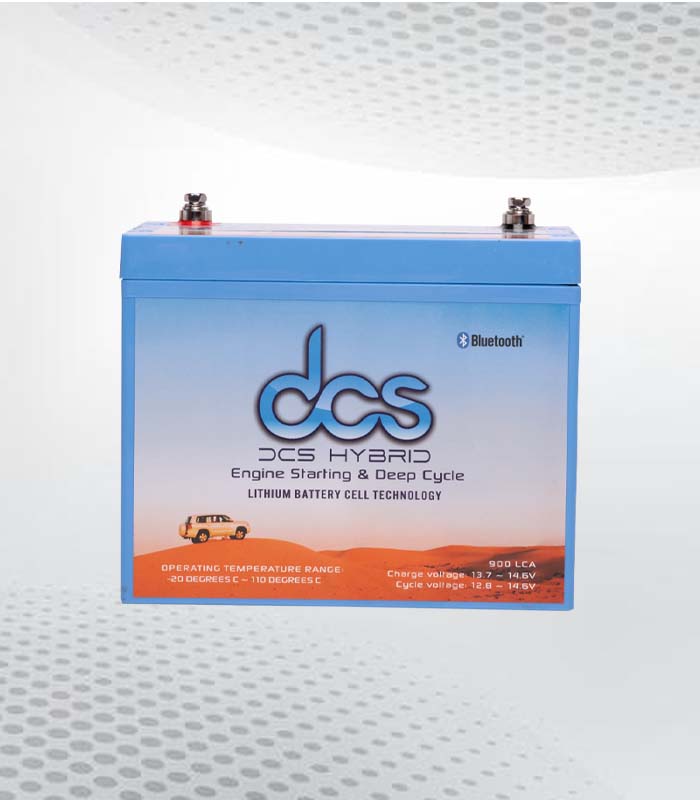Deep cycle batteries provide consistent and reliable power over extended durations. These batteries differ significantly from standard car batteries, which are designed for short, high-power bursts to start an engine. Deep cycle batteries, however, are engineered to deliver a steady stream of energy, which is essential for powering devices and systems over long periods. This capability makes them particularly suitable for marine applications, where consistent power is needed to operate electronics, lighting, and other critical systems. One of the notable variants in this category is the Marine Deep Cycle Battery 100ah, which offers a blend of high capacity and durability.
Understanding Marine Deep-Cycle Battery 100ah
The Marine Deep-Cycle Battery 100ah is designed to meet the specific power demands of aquatic environments. It boasts high capacity and resilience, essential for withstanding the rigours of maritime activities. This type of battery delivers a continuous and reliable power supply, crucial for operating marine electronics, lighting, and other onboard systems. Its robust construction ensures it can handle vibrations and temperature variations common in aquatic settings.
Additionally, the 100Ah capacity provides ample energy for extended use, making it an ideal choice for small to medium-sized boats. The focus on durability and consistent performance underscores its suitability for marine applications.
Exploring Marine RV Deep Cycle Battery
Marine RV Deep Cycle Battery is specifically crafted to meet the power requirements of recreational marine vehicles. These batteries are built to endure the physical demands of aquatic environments, such as vibrations and temperature fluctuations. They provide a dependable power source for various onboard systems, including lighting, appliances, and electronic devices, ensuring that recreational activities remain uninterrupted.
The design considerations for marine RV deep cycle batteries include robust construction and optimised performance, making them a reliable choice for those seeking durability and consistent energy supply during their maritime adventures. These batteries significantly enhance the comfort and functionality of marine recreational vehicles.
Lithium RV Battery 200Ah: An Overview
Lithium RV batteries, especially the 200Ah models, stand out due to their superior features to traditional lead-acid counterparts. They are significantly lighter, which is advantageous for marine and RV applications where weight is a concern. These batteries boast an extended lifespan, offering many more charge cycles, and their ability to charge rapidly is a distinct benefit.
Additionally, Lithium RV Battery 200ah maintains consistent power output with minimal performance degradation, ensuring a dependable energy supply. This makes them an attractive option for those prioritising efficiency and longevity in their power systems. The advanced technology incorporated in these batteries enhances their overall reliability and performance in various demanding environments.
Marine Deep Cycle Battery Maintenance Tips
Regular inspection of marine deep-cycle batteries ensures their longevity and reliability. Key maintenance practices include checking and cleaning battery terminals to prevent corrosion, which can impede performance. Proper fluid levels in batteries that require topping up are also vital. Batteries should be charged using an appropriate charger to avoid overcharging or undercharging, which can reduce their lifespan. Keeping the battery clean and free from debris helps prevent potential issues.
Additionally, storing the battery in a cool, dry place when not in use helps maintain its condition. Proper ventilation during charging prevents dangerous gas build-up, enhancing safety. Following these maintenance tips helps ensure the battery remains ready for reliable performance in marine applications.
Comparing AGM and Gel Marine Deep Cycle Batteries
AGM (Absorbent Glass Mat) and gel marine deep cycle batteries are widely recognised for their performance and durability in maritime applications. AGM batteries, featuring a fibreglass mat that absorbs the electrolyte, are known to provide high current output and quick recharge times, making them suitable for high-power demands. They are less prone to spillage and can operate efficiently in various orientations.
Conversely, gel batteries utilise a gelled electrolyte, offering superior resistance to vibration and extreme temperatures. This makes them particularly advantageous in harsh marine environments. Though generally more expensive, gel batteries provide consistent and stable performance. The choice between AGM and gel batteries often hinges on the specific requirements of the marine application, balancing cost, performance, and durability considerations.
Choosing the Best Deep Cycle Battery for Boat
Selecting the Best Deep Cycle Battery for Boat requires careful consideration of various factors. Capacity is critical, with a marine deep cycle battery of 100Ah, often providing a suitable balance for small to medium-sized vessels. Weight and size are also pivotal, ensuring compatibility with the boat’s existing systems without adding unnecessary bulk.
Another crucial factor is the battery’s ability to handle the demands of marine environments, such as resistance to vibrations and temperature fluctuations. Marine batteries must support all onboard electrical systems, from essential navigation tools to leisure appliances, ensuring uninterrupted functionality during maritime activities.
Environmental Impact of Marine Batteries
The environmental impact of marine batteries is a growing concern, particularly with traditional lead-acid variants, which contain hazardous materials that pose disposal challenges. If not managed properly, these batteries can leak harmful substances into the environment, affecting ecosystems. Advances in battery technology have introduced more sustainable options, such as lithium-ion batteries, which have a lower environmental footprint due to their higher energy efficiency and longer lifecycle.
Lithium batteries also contain fewer toxic materials, making them easier to recycle. Following proper recycling and disposal procedures is essential to mitigate any potential environmental harm. Regulatory frameworks are increasingly advocating for sustainable battery production and disposal practices, emphasising the importance of minimising environmental impact. Marine industry stakeholders are encouraged to adopt eco-friendly battery solutions to contribute to environmental conservation efforts.
Technological Advancements in Deep Cycle Batteries
Recent technological advancements in deep-cycle batteries have significantly enhanced their performance and reliability. Innovations such as advanced battery management systems have optimised charging and discharging processes, ensuring batteries operate efficiently under various conditions. Introducing new materials, such as lithium iron phosphate, has increased energy density and reduced weight, providing more power in a smaller, lighter package.
Improvements in internal construction techniques have also contributed to greater durability and longer life cycles, which are particularly beneficial in demanding marine environments. Enhanced thermal management systems have improved safety and performance by maintaining optimal operating temperatures.
Additionally, the development of smart battery technology allows for real-time monitoring and diagnostics, providing users with critical information about the battery’s status and health. These advancements collectively contribute to the evolution of deep-cycle batteries, making them more dependable and efficient for various applications.
Safety Considerations for Using Deep Cycle Batteries
Ensuring the safety of deep-cycle batteries in marine environments requires adherence to specific guidelines and practices. Batteries should be installed securely to prevent movement and potential short circuits caused by vibrations or impacts. Regular inspection for any signs of physical damage, such as cracks or corrosion, is crucial. Protective gear, such as gloves and eye protection, is recommended to avoid contact with corrosive materials when handling batteries. Proper ventilation is essential to dissipate any gases produced during charging, reducing the risk of explosion.
Additionally, using battery cases or covers can protect against accidental short circuits and exposure to elements. Clear labelling and knowledge of emergency procedures in case of battery failure or leaks are vital. By following these safety measures, the risk of accidents and damage can be minimised, ensuring the reliable and secure operation of deep-cycle batteries in various marine settings.
Cost Analysis of Marine Deep Cycle Batteries
The cost of marine deep cycle batteries can vary significantly based on several factors, including the type of battery, its capacity, and specific features. Traditional lead-acid batteries are more affordable upfront but may require more frequent replacements. In contrast, lithium-ion batteries, while more expensive initially, offer extended lifespans and reduced maintenance needs, potentially leading to lower overall costs in the long run.
Factors such as energy efficiency and durability are critical in the cost analysis. For many users, the Marine Deep-Cycle Battery 100ah presents a balanced option, providing reliable performance without the higher cost associated with more advanced models. Assessing immediate and long-term costs is crucial in determining the most cost-effective choice for specific marine applications.
Real-World Applications of Deep Cycle Batteries
Deep cycle batteries are integral to many marine and RV applications, ensuring consistent power for critical and auxiliary systems. In marine settings, these batteries support navigation equipment, communication devices, and onboard lighting, enhancing operational efficiency and safety. RVs benefit from deep cycle batteries by powering essential appliances such as refrigerators, microwaves, and entertainment systems, providing home-like convenience on the road.
Moreover, they enable using renewable energy sources, like solar panels, by storing energy for later use. The robust design of these batteries allows them to withstand the unique challenges of mobile and maritime environments, including vibrations, temperature fluctuations, and prolonged use. This versatility underscores their value in maintaining continuous and reliable power across diverse applications.
Conclusion
Choosing the right Marine Deep Cycle Battery 100ah involves balancing capacity, durability, and environmental considerations. While traditional lead-acid batteries offer an initial cost advantage, AGM and gel variants provide enhanced performance and resilience in marine environments. Lithium-ion batteries, though pricier, offer superior longevity and efficiency. Proper maintenance is crucial for all types to ensure reliability. Technological advancements are continuously improving deep cycle battery performance and sustainability. Safety should always be a top priority during installation and use. Ultimately, selecting the ideal battery depends on the specific power needs and environmental demands of the marine application, considering both immediate and long-term costs.
FAQ’s
What is the primary difference between a deep cycle battery and a regular car battery in marine applications?
Deep cycle batteries are designed for long, sustained power output and can withstand deep discharges, whereas car batteries provide short bursts of high power for starting engines.
What are some key factors to consider when choosing the best deep cycle battery for a boat, especially a 100Ah model?
Key factors include capacity (100Ah in this case), weight, size, resistance to marine conditions (vibrations, temperature), and the power requirements of all onboard electrical systems.
What are some essential maintenance tips to prolong the life and reliability of a marine deep cycle battery?
Essential tips include regular inspection for corrosion, maintaining proper fluid levels (for some types), using an appropriate charger, keeping the battery clean, and ensuring proper ventilation during charging. Note: lithium batteries do not require fluid level checks or regular terminal cleaning.
What are the key differences and benefits of AGM and gel marine deep cycle batteries?
AGM batteries offer high current output and quick recharge times, while gel batteries provide superior resistance to vibration and extreme temperatures, often with a more consistent performance over time.
How are technological advancements improving deep cycle batteries for marine use?
Advancements include better battery management systems, new materials like lithium iron phosphate for increased energy density and reduced weight, improved internal construction for durability, enhanced thermal management, and smart battery technology for real-time monitoring.
Related Business Listings
Contact Directory
Local Business Profiles




